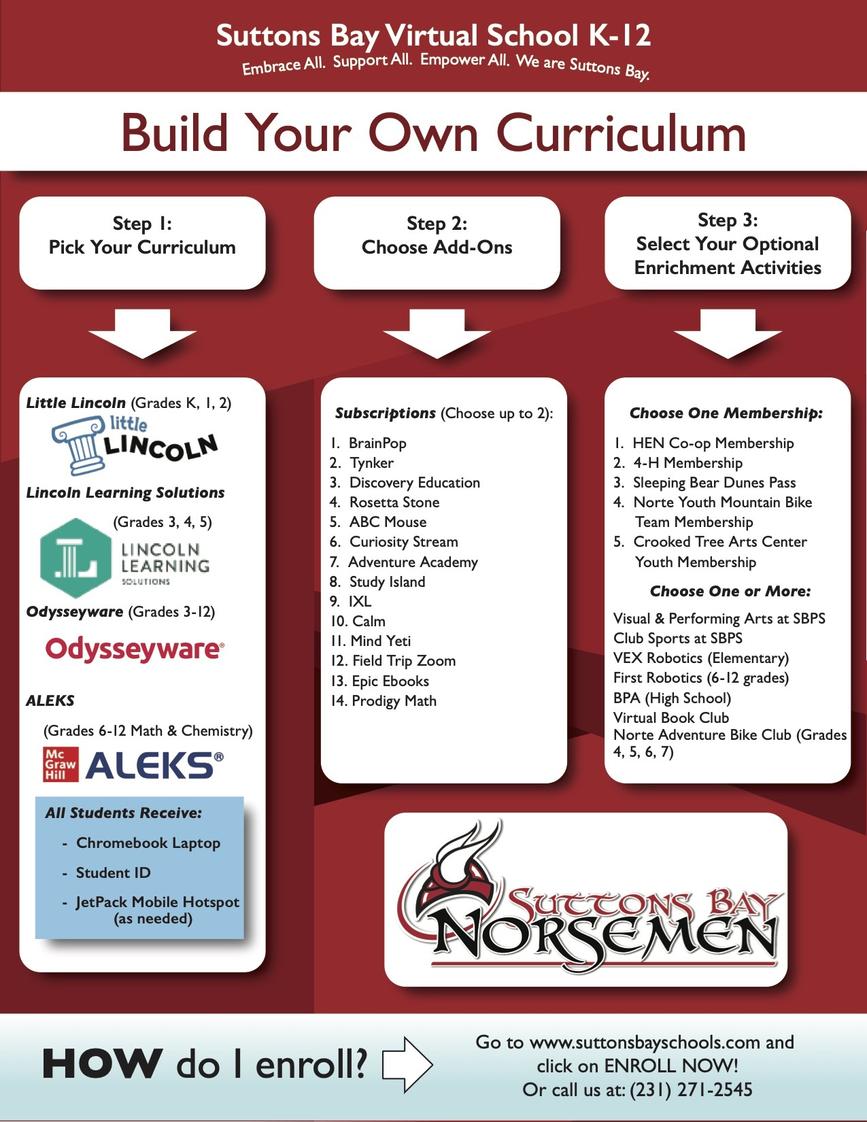Serving 183 students in grades Kindergarten-12, Suttons Bay Virtual School ranks in the bottom 50% of all schools in Michigan for overall test scores (math proficiency is bottom 50%, and reading proficiency is bottom 50%).
The percentage of students achieving proficiency in math is 10-14% (which is lower than the Michigan state average of 35%). The percentage of students achieving proficiency in reading/language arts is 40-44% (which is lower than the Michigan state average of 45%).
The student-teacher ratio of 31:1 is higher than the Michigan state level of 17:1.
Minority enrollment is 16% of the student body (majority Hispanic), which is lower than the Michigan state average of 37% (majority Black).
Quick Facts (2025-26)
- School Type: Online School
- Grades: Kindergarten-12
- Enrollment: 183 students
- State Accredited: No
- Live Instruction: No
- Rolling Enrollment: No
- Student-Teacher Ratio: 31:1
- Minority Enrollment: 16%
- Graduation Rate: 50-59% (Btm 50% in MI)
- Overall Testing Rank: Bottom 50%
- Math Proficiency: 10-14% (Btm 50%)
- Reading Proficiency: 40-44% (Btm 50%)
- Science Proficiency: 30-39% (Btm 50%)
- Source: National Center for Education Statistics (NCES), MI Dept. of Education
School Overview
Suttons Bay Virtual School's student population of 183 students has declined by 8% over five school years.
The teacher population of 6 teachers has stayed relatively flat over five school years.
School Type
Grades Offered
Grades Kindergarten-12
(Primarily virtual)
(Primarily virtual)
Total Students
183 students
Gender %
Total Classroom Teachers
6 teachers
State Accredited Program
No
Personalized Content
No
Live Instruction
No
Rolling Enrollment
No
Flexible Class Schedule
No
Accelerated Offerings
No
Classes for Credit/Part Time Options
No
Dedicated College Counselor
No
Tutoring/Mentoring
No
Community Clubs/Activities Offered
No
School Calendar
School Rankings
Suttons Bay Virtual School ranks within the bottom 50% of all 3,025 schools in Michigan (based off of combined math and reading proficiency testing data).
The diversity score of Suttons Bay Virtual School is 0.29, which is less than the diversity score at state average of 0.56. The school's diversity has stayed relatively flat over five school years.
Overall Testing Rank
#2138 out of 3025 schools
(Bottom 50%)
(Bottom 50%)
Math Test Scores (% Proficient)
10-14%
35%
Reading/Language Arts Test Scores (% Proficient)
40-44%
45%
Science Test Scores (% Proficient)
30-39%
38%
Student-Teacher Ratio
31:1
17:1
American Indian
3%
1%
Asian
n/a
4%
Hispanic
6%
9%
Black
n/a
18%
White
84%
63%
Hawaiian
n/a
n/a
Two or more races
7%
5%
All Ethnic Groups
Graduation Rate
50-59%
81%
Participates in the National School Lunch Program (NSLP)
Yes
Eligible for Free Lunch
56%
50%
Eligible for Reduced Lunch
4%
4%
School Statewide Testing
School District Name
Sports
Total Sports Offered
8 sports
Sports
BaseballBasketball
Cross CountryCross Country Running
FootballSoccer
Track and FieldVolley Ball
Extracurriculars
Total ExtracurricularsTotal Extra-curric.
1 extracurricular
ExtracurricularsExtra-curric.
Club or Organization:
National Honor Society
Source: National Center for Education Statistics (NCES), MI Dept. of Education
School Notes
- Suttons Bay Virtual School is an established K-12, tuition-free, public school that provides individualized online education for every student. Students who earn the required 18 credits graduate with a Suttons Bay High School diploma. We develop genuine, caring relationships with our students and families and our certified teachers are local and available to work in-person if needed.
Profile last updated: 02/09/2025
Frequently Asked Questions
What is Suttons Bay Virtual School's ranking?
Suttons Bay Virtual School is ranked #2138 out of 3,025 schools, which ranks it among the bottom 50% of public schools in Michigan.
What percent of students have achieved state testing proficiency in math and reading?
10-14% of students have achieved math proficiency (compared to the 35% MI state average), while 40-44% of students have achieved reading proficiency (compared to the 45% MI state average).
What is the graduation rate of Suttons Bay Virtual School?
The graduation rate of Suttons Bay Virtual School is 50-59%, which is lower than the Michigan state average of 81%.
How many students attend Suttons Bay Virtual School?
183 students attend Suttons Bay Virtual School.
What is the racial composition of the student body?
84% of Suttons Bay Virtual School students are White, 7% of students are Two or more races, 6% of students are Hispanic, and 3% of students are American Indian.
What is the student-teacher ratio of Suttons Bay Virtual School?
Suttons Bay Virtual School has a student ration of 31:1, which is higher than the Michigan state average of 17:1.
What grades does Suttons Bay Virtual School offer ?
Suttons Bay Virtual School offers enrollment in grades Kindergarten-12 (Primarily virtual).
What school district is Suttons Bay Virtual School part of?
Suttons Bay Virtual School is part of Suttons Bay Public Schools.
School Reviews
Review Suttons Bay Virtual School. Reviews should be a few sentences in length. Please include any comments on:
- Quality of academic programs, teachers, and facilities
- Availability of music, art, sports and other extracurricular activities
Recent Articles

School Vouchers: Updated Pros and Cons (2025 Review)
Comprehensive 2025 analysis of school vouchers, weighing benefits and challenges for families, funding, outcomes, and policy directions.

Benefits and Drawbacks of Homework in 2025
Explore updated 2025 insights on homework鈥檚 benefits, drawbacks, mental health impact, best practices, and policy trends in U.S. public schools.

Charter Schools vs Public Schools 2025: Key Differences & Trends
Explore updated 2025 insights comparing charter schools vs public schools, enrollment, academic outcomes, funding, and real-world examples for families and educators.









